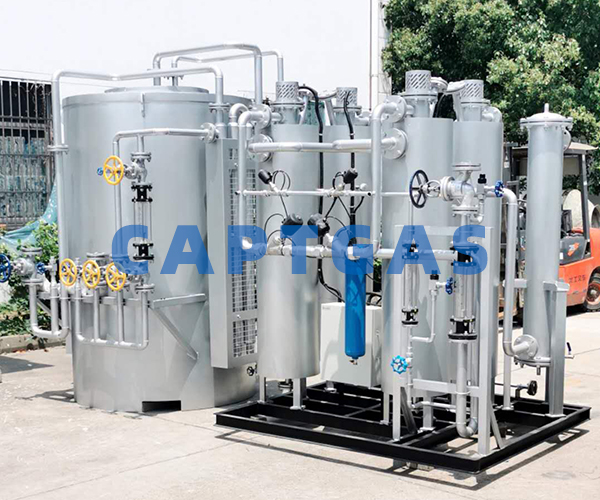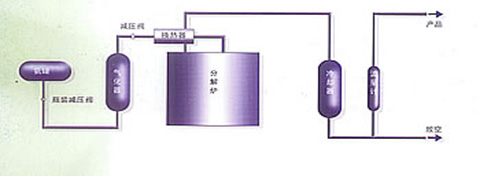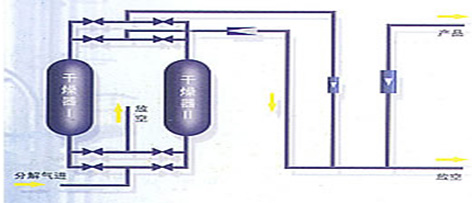Click to add WeChat
Captgas equipment Co., Ltd-Suzhou

A brief description of the ammonia decomposition work of the Suzhou CAPTGAS brand:
Each kilogram of liquid ammonia cracking can produce 2.64Nm3 mixed gas, which contains 75% hydrogen and 25% nitrogen. After ammonia is cracked, the resulting gas contains less impurities (about 2 g/m3 of water vapor in the impurities, and about 0.01% of residual ammonia). After passing through a molecular sieve adsorption purifier, the dew point of the gas can be reduced to -600C to -700C. Residual ammonia can be reduced to below 3PPM.
Ammonia cracking hydrogen production furnace can be used for bright annealing of non-ferrous metals, silicon steel, chromium steel and stainless steel and other metal materials and parts, decarburization treatment of silicon steel sheets, copper-based, iron-based powder metallurgy sintering, and hydrogen-burning treatment of metal parts of electric vacuum devices , Protection sintering and sealing of semiconductor devices, palladium alloy membrane diffusion and purification of hydrogen raw material gas, etc.
The raw material ammonia is easy to obtain, the price is low, and the raw material consumption is less. Ammonia cracking to produce protective gas has the advantages of low investment, small size and high efficiency.
The working principle of Suzhou Kaipu ammonia decomposition
Ammonia (gaseous) is cracked into 75% hydrogen and 25% nitrogen under the action of a catalyst at a certain temperature and pressure, and absorbs 21.9 kcal of heat. The main reactions are:
2NH3—3H2+N2-21.9 kcal
Because the whole process is an endothermic reaction, increasing the temperature is conducive to ammonia cracking. At the same time, it is a reaction that expands in volume. Lowering the pressure is conducive to the decomposition of ammonia. Generally, it is controlled at about one atmosphere and the temperature is between 800-850℃. Due to use requirements, the gas source must be pressurized and palladium catalytic deoxygenation (additional part).

The purity of the pyrolysis hydrogen is very high. There are only traces of residual ammonia and water in the volatile impurities. It can be seen that only a small amount of residual ammonia and water can be removed to obtain high-purity gas. Gas purification adopts temperature swing adsorption technology. The temperature swing adsorption (TSA) technology is a gas separation and purification process based on the different adsorption performance of the internal surface of the adsorbent (porous solid material) on the gas molecules at different temperatures. The impurity gas is adsorbed at room temperature, and the impurity gas is desorbed when heated. .
The surface of the molecular sieve is all microporous, and it can absorb 20% of its own weight (water and impurities during static adsorption) under normal temperature and pressure to obtain product gas with qualified purity and impurity content. The surface of the molecular sieve is all microporous. Under normal pressure, it can absorb 20% of its own weight (moisture and impurities during static adsorption, and at a temperature of about 350℃, it can be regenerated completely. The purification device is automatically switched every 24 hours under the control of the valve to obtain purity. Product gas with qualified impurity content.

Cape equipment model and main parameters
|
model |
rated gas production |
liquid ammonia consumption |
operating temperature |
catalyst |
power supply |
rated power |
cooling water consumption |
|
AF-5B/FC-5 |
5 |
2 |
600~650 |
iron catalyst |
220 |
5.5 |
-- |
|
AF-5C/FC-5 |
5 |
2 |
800~850 |
nickel catalyst |
220 |
6 |
0.2 |
|
AF-10/FC-10 |
10 |
4 |
800~850 |
nickel catalyst |
380 |
12 |
0.5 |
|
AF-20/FC-20 |
20 |
8 |
800~850 |
nickel catalyst |
380 |
24 |
1 |
|
AF-30/FC-30 |
30 |
12 |
800~850 |
nickel catalyst |
380 |
36 |
1.5 |
|
AF-40/FC-40 |
40 |
16 |
800~850 |
nickel catalyst |
380 |
50 |
2 |
|
AF-50/FC-50 |
50 |
20 |
800~850 |
nickel catalyst |
380 |
70 |
2.5 |
|
AF-60/FC-60 |
60 |
24 |
800~850 |
nickel catalyst |
380 |
75 |
3 |
|
AF-80/FC-80 |
80 |
32 |
800~850 |
nickel catalyst |
380 |
80 |
3.5 |
|
AF-100/FC-100 |
100 |
39 |
800~850 |
nickel catalyst |
380 |
95 |
4 |
|
AF-150/FC-150 |
150 |
59 |
800~850 |
nickel catalyst |
380 |
140 |
5 |
|
AF-200/FC-200 |
200 |
77 |
800~850 |
nickel catalyst |
380 |
180 |
6 |
Note: For more detailed parameters, please contact captgas professional sales engineers, thank you for your support!